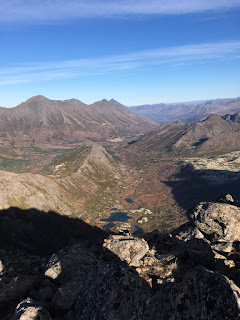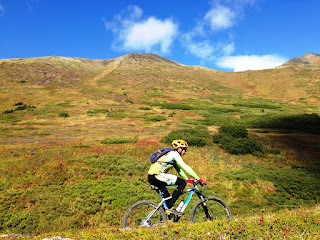This winter, the season is playing hard to get: cold and
dry.
If it weren’t for a few copious snowfalls above 3,000 FSL in
the Talkeetnas in late October, there’d be no skiing at all.
As it is, the snowpack is weak, and ready for a disaster if
the pattern shifts and dumps heaps of snow up there. On the plus side, a crust
formed over Halloween has given the normally dry and airy snow of that range
some armored base to protect bases from ever-lurking granite.
Meredith and I had planned only to go Nordic skiing at
Independence mine two weekends ago, but a few pictures from Jack made me think
we might go for a tour first and look for softer snow in sheltered locations where
the winds hadn’t totally decimated the surface conditions. A lack of avalanche
activity following the Halloween cycle indicated we could safely venture out on
moderate slopes.
We tossed in skins and wide planks along with our Nordic
gear, and I envisioned a little schussing about in some mellow rock gardens where
the snow pack would be anchored and hopefully playful.
An hour of touring and a pit later, and we realized
conditions were a lot better than we hoped, and another hour later we were
cautiously but hopefully navigating our way up the ridge to Gold Cord Peak.
The wind had done a number to the snow, but had been
consistent and predictable in its work: if it looked wind-effected, it was.
Everything else though, was really pleasant.
Despite a temperature of 10 in the parking lot, we enjoyed
two sunny laps from the top of Gold Cord Peak.
A week later, we returned. A light snowfall and some
occasional gusty breezes had complicated surface conditions a tad, but done
little to the avalanche quotient.
Not seeing our tracks from the previous week on the front
face of GCP, we were lured back to the top. The winds’s effect had been less
predictable and bit more swirly, and the firm base created by the Halloween
event showed signs of weakening in places, providing an occasionally punchy
consistency beneath, but was still worth yet another two sunny runs.
 |
| I've missed these views. |
 |
| Photo: M.N. |
 |
| Photo: M.N. |
 |
| Checking out the "Dream Cabin." |
 |
| Photo: M.N. |
The next day, a Saturday, Cody and I returned. Expecting the
crowds to be on the thick side, we move toward Friendship Pass area. Along the
way we looked longingly into hidden couloir (no idea if this is really its
name) on the side of Granite. A week prior, the line had been ridden by a
snowboarder who appeared to have booted all the way from the parking lot up to Gold
Cord Mine and up the line. Those tracks had been completely erased by the
snowfall and wind, so we decided to give it a go.
We agreed to commit to backing out if we entered the chasm
and found conditions to be firm or variable/punchy, and not suckered into the
old: “maybe it’ll get better,” because after all, it almost never does.
Well, almost reared its head, because it did get
better.
Just above the apron, conditions were briefly firm enough
that we were only toeing-in to the stiff windboard. I think the only reason we
didn’t stop right then and there is that neither of us wanted to step into gear
on such firm conditions.
A bit higher up and conditions softened some, but still
weren’t great. One side of the line was actually quite nice, right down the
middle there appeared to be a buried slough path that provided great booting, while
the other half of the line was deeper with a punchy crust buried too deep to impact
skiing, though not ideal for climbing as our boots easily busted through.
Each step seemed to reveal improved snow quality though, and
lured us upward toward the gleaming beams of sun poking over the top.
Near the top, the line widened with a pile of protruding
boulders in the middle; to either side, we found some of the nicest snow of the
whole line.
The top out was the only place we finally found evidence of
the boarder who had skied it a week or more prior. His or her cautious
side-slip entry was still evident, and had been solidified, to make the final
25 feet very firm.
Up in the sun, we had a magnificent view into the Willow
Creek drainage.
We agreed to take our time and ski very conservatively to
adapt for the changing – and what would be generally deteriorating – snow
quality, as we descended.
The entry was firm and steep, requiring a side slip to get
back down to the soft snow below.
Re-grouped, I took the first crack, and skied half the line to
get behind a nice alcove.
The snow rode much better than expected, but the top 3-4
inches easily popped loose and ran in 20’ x 20’ sheets, creating significant
but slow slough runs down the center.
Part two of the line skied a little rougher, but we knew what
was coming, and the slough we knocked loose above provided a consistent bed to
ride on top of until we hit the creamy apron.
Having fulfilled our quota of booting, we mooched a fresh
skinner from a departing group into an adjacent pillow playground, and had a
great evening run riding through a series of shoots and pillows to end the day.
 |
| Hidden couloir is hardly hidden from Gold Cord Peak. The chutes and pillows on the lookers right slope were a treat. |
 |
| From below. |
 |
| Up top. Photo: C.G. |
 |
| Dropping in. Photo: C.G. |
 |
| Still soft halfway down. |
 |
| High grade. |
 |
| Fresh snow and zero viz meant staying out of the mountains on Sunday. Fortunately there's enough snow in Kincaid for skinny ski adventures! |
Here’s to hoping for more adventures in the Talkeetnas this
winter, and being grateful for finally getting back into them after such a long
hiatus.
















































